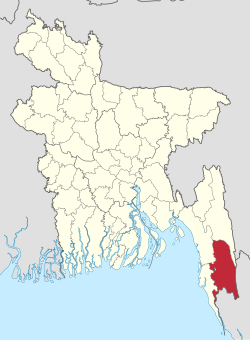Top Qs
Timeline
Chat
Perspective
Bandarban District
District of Bangladesh in Chittagong Division From Wikipedia, the free encyclopedia
Remove ads
Bandarban District (Bengali: বান্দরবান জেলা), officially Bandarban Hill District, is a district in South-Eastern Bangladesh, and a part of the Chittagong Division.[6] It is one of the three hill districts of Bangladesh and a part of the Chittagong Hill Tracts, the others being Rangamati District and Khagrachhari District. Bandarban district (4,479 km2) is not only the most remote district of the country, but also the least populous (population 388,000).[7] There is an army contingent at Bandarban Cantonment.
Remove ads
Demographics
Summarize
Perspective
According to the 2022 Census of Bangladesh, Bandarban District had 106,065 households and a population of 481,106 with an average 4.41 people per household. Among the population, 110,625 (22.99%) inhabitants were under 10 years of age. The population density was 107 people per km2. The literacy rate (age 7 and over) was 63.74%, compared to the national average of 74.80%. The sex ratio of the district was at 105 males for 100 females. Approximately, 40.41% of the population lived in urban areas.[9][4]

As per the 2022 census, there were 283,123 (58.85%) Bengalis and 197,983 (41.15%) minorities (called Upojati) people in the district.[10][3] The population of major ethnic minorities living in the district besides the Bengalis, are: Marma: 84,170, Mro/Murong 51,448, Tripura 22,572, Tanchangya 14,889, Bom 11,854, Chakma 3,712, Khumi 3,287, Chak 2,662, Khyang 2,502.
Bengalis
According to the 2022 census, Bengalis are the largest ethnic group in Bandarban District (58.85%).
They are largest ethnic group in Naikhongchhari Upazila (83.48%), Lama Upazila (76.22%), Alikadam Upazila (60.64%) and Bandarban Sadar Upazila (56.97%).[9]
Marmas
According to the 2022 census, Marmas are the second largest ethnic group in Bandarban District (17.50%).
They are the largest ethnic group in Rowangchhari Upazila (49.48%), Thanchi Upazila (31.37%) and Ruma Upazila (31.04%).[9]
Mrus
According to the 2022 census, Mru (Murong) are the third largest ethnic group in Bandarban District (10.69%).
They are the second largest ethnic group in Alikadam Upazila (23.77%), Thanchi Upazila(23.57%) and Ruma Upazila (22%).[9]

Tripura
According to the 2022 census, Tripuras are fourth largest ethnic group in Bandarban District (4.69%).[9]
Tanchangyas
According to the 2022 census, Tanchangyas are the fifth largest ethnic group in Bandarban District (3.09%).
They are the second largest ethnic group in Rowangchhari Upazila(14.39%).[9]
Boms
According to the 2022 census, there are 12,311 Bom in CHT. Among them, 11854 (96.29%) Boms live in Bandarban District, constituting 2.46% of district's population.
They are third largest ethnic groups in Ruma Upazila (19.89%).[9]
Chakmas
According to the 2022 census, there are 3,713 Chakma in Bandarban district.[9]
Khumi
According to the 2022 census, there are 3,287 Khumis in Bandarban district.[9]
Chaks
According to the 2022 census, there are 2,662 Chaks in Bandarban district.
They are mainly concentrated in Naikhongchhari Upazila, constituting 3.05% of the upazila's population.[9]
Khyangs
According to the 2022 census, there are 1,670 Khyangs in Bandarban district.[9]
Remove ads
Religion
Summarize
Perspective
The religious composition of the population in 2022 was 52.74% Muslim, 29.53% Buddhist, 9.78% Christian, 3.43% Hindu and 4.52% others.[10] Religious institutions is Mosque 2,070, Buddhist 1500 (256 temples, 644 pagodas), Hindu temple 194 and Church 2.[12]
Islam
According to 2022 census, Islam is the largest religion in Bandarban District(52.74%).
Buddhism
According to 2022 census, Buddhism is the second largest in Bandarban District(29.53%).
Christianity
According to 2022 census, Christianity is third largest religion in Bandarban district(9.78%).
Hinduism
According to 2022 census, Hinduism is the fourth largest in Bandarban district(3.43%).
Remove ads
Subdistricts
Tourism
Summarize
Perspective
The India – Myanmar Sabroom – Cox's Bazar railway link has been proposed to connect Sabroom – Khargachari – Rangamati – Bandarban – Satkania – Cox's Bazar and another rail link connecting Bandarban to Tuipang, India.
Bandarban lies, by bus, eight hours away from Dhaka, two hours from Chittagong and three hours from Cox's Bazar. It is also possible to get there by a six-hour bus ride from Rangamati. The Buddha Dhatu Jadi, the Buddhist temple in Bangladesh, located in Balaghata, 4 km from the town. This place attracts many tourists every year. This Theravada Buddhist temple is made completely in the style of South-East Asia and houses the second largest statue of the Buddha in Bangladesh. The waterfall named Shoilo Propat at Milanchari is another place tourists like to visit. The numerous Buddhist temples, known as kyang in local tongue, and bhihars in the town include the highly notable the Rajvihar (royal vihar) at Jadipara and the Ujanipara Bhihar. Bawm villages around Chimbuk, and Mru villages a little further off, are also lie within a day's journey from the town. Prantik Lake, Jibannagar and Kyachlong Lake are some more places of interest. Boat ride on the river Shangu is one of the main attractions here for tourists.
Starting on January 7, 2015 the Home Ministry has enforced the provision of "no free passes" for foreigners visiting the three Chittagong Hill Tracts districts – Rangamati, Khagrachhari and Bandarban. As a result, foreigners need to submit an application to the Home Ministry a month ahead for their scheduled visit.[13]
Remove ads
Notable persons
Notes
- Including Jainism, Zoroastrianism, Judaism, Ad-Dharmis, or not stated
References
See also
Further reading
External links
Wikiwand - on
Seamless Wikipedia browsing. On steroids.
Remove ads






